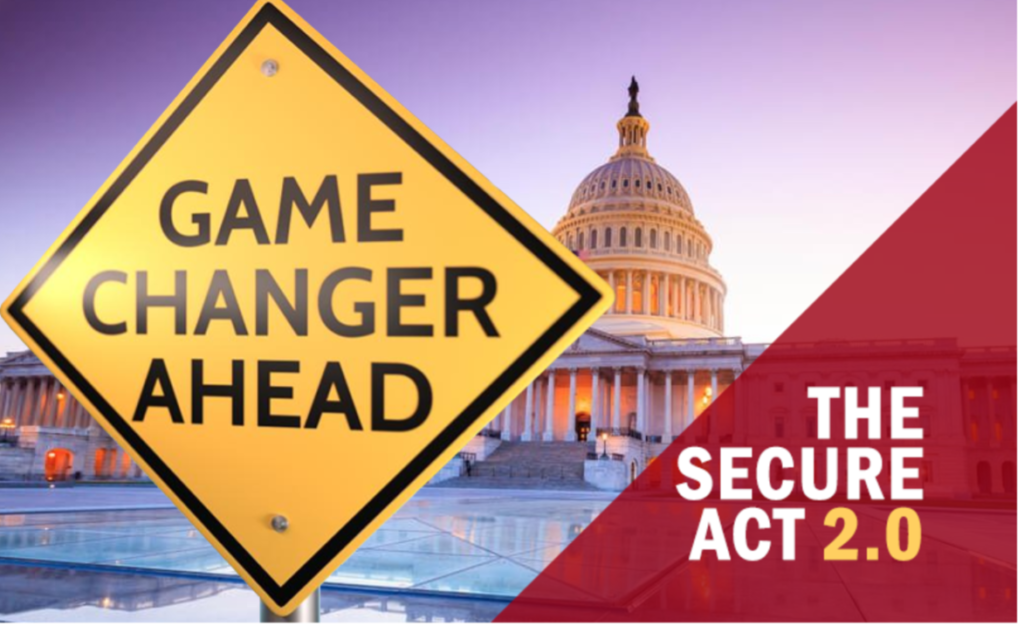
The SECURE 2.0 Act is designed to help Americans bolster their retirement savings and strengthen their financial security. Here’s what you need to know about the SECURE 2.0 Act of 2022.
Key Provisions of the SECURE 2.0 Act
Increase Required Minimum Distributions (RMD) Age
The SECURE 2.0 Act increase the beginning date for RMDs from age 72 to 73 starting in 2023. The age increased to age 75 in 2033. This is a game changer. It’s significant because it allows you to preserve your tax deferral in retirement accounts longer.
Increase Catch-Up Contributions Under a Retirement Plan or IRA
In 2023, the retirement plan catch-up contribution limit for those over 50 is $7,500. Starting in 2025, catch-up contributions for those ages 60 to 63 will be increased to the greater amount of $10,000 or 50% more than the regular catch-up contribution amount in 2024. In addition, catch-up contributions will be indexed for inflation starting after 2025. IRA catch-up contribution for an individual who turns age 50 will be indexed for inflation starting in 2024.
Expand Roth Contributions
Roth contributions are now allowed for SIMPLE and SEP IRAs. Employer contributions and employee elective deferrals (if permitted) can be designated as Roth.
Roth Catch-Up Contributions
For those with incomes exceeding $145,000, catch-up contributions will be designated as Roth contributions.
Eliminate RMDs for Roth 401(k) Accounts
Starting in 2024, required distributions will no longer need to be taken from Roth 401(k) accounts.
529 Plan Rollovers to Roth IRAs
Starting in 2024, beneficiaries of 529 plans may roll over up to $35,000 during their lifetime to a Roth IRA. The rollovers will be subject to annual contribution limits and the 529 plan must have been open for more than 15 years. One of the biggest perceived downsides of the 529 saving plan was the possibility that the funds go unused. This change will significantly reduce or eliminate this concern.
Expand 401(k) Automatic Enrollment
Starting in 2025, 401(k) and 403(b) plan participants are automatically enrolled in the plan once they are eligible to participate. Some details are:
- Initial contribution of at least 3% of their salary
- Each year contributions would increase by 1% until a goal of 10% is reached, but not more than 15%
Emergency Savings Account
Beginning in 2024, employers can establish an emergency savings account where employees can save up to $2,500 in a Roth-style account. Distributions will be treated like a qualified distribution from a Roth account (tax-free if requirements are met).
Exemption from 10% Early Distribution Penalty for Withdrawals for Certain Emergency Expenses
In case of financial hardship, up to $1,000 may be withdrawn per year, penalty free, from a 401(k) or IRA. The employee has the option to repay the distribution within 3 years. No further distributions will be permitted during the repayment period unless the distribution is paid in full.
Modify the Saver’s Credit
To encourage those with low and moderate incomes, an eligible individual who makes a qualified retirement savings contribution shall be allowed a matching contribution. Starting in 2027, the government will provide 50% credit on savings up to $2,000 ($1,000 maximum credit). Credit is available regardless of whether the taxpayer has an income tax liability.
Student-Loan Matching Program
Student loan payments will be treated as Employee Elective Deferral for purposes of matching contributions.
Increase Qualified Longevity Annuity Contract (QLAC) Contributions
Up to $200,000 can be contributed into a qualified longevity annuity contract. The prior 25% of income limit is eliminated.
Reduce RMD Excise Tax
Reduced excise tax for failure to take required distributions from 50% to 25%.
Expand Qualified Charitable Distributions (QCD)
The QCD rules are expanded to allow for a one-time $50,000 distribution to a charity through a split-interest entity, including charitable gift annuities, charitable remainder unitrusts, and charitable remainder annuity trusts. Beginning in 2024, the $100,000.00 annual limit on QCDs will be indexed for inflation.
Annuities in 401(k) Plans
Removal of barriers to the use of annuities in qualified plans by exempting certain annuity features from actuarial tests that would otherwise prohibit their use.
Retirement Savings Lost and Found
The Labor Department will create a national online searchable lost and found database.
What do I do next?
We are still waiting for guidance from the IRS and financial custodians on how to process what has been passed. As with many political bills, there is still a lot of confusion and we are awaiting clarity. Depending on your life and family situation, it’s likely that something in this bill will apply to you now or in the future.
The most important takeaway is how important it is to have a team of professionals that you can turn to. Specialists like United Benefits can help you decipher this and other complex financial issues and determine the most appropriate path forward. Little changes often compound into tremendous returns in the long run. If you need guidance on your specific situation, get int touch with a United Benefits Retirement Specialist using the form below.
Disclosures: United Benefits and its affiliates do not provide tax, legal or accounting advice. This material has been prepared for informational purposes only, and is not intended to provide, and should not be relied on for, tax, legal or accounting advice. You should consult your own tax, legal and accounting advisors before engaging in any transaction.
